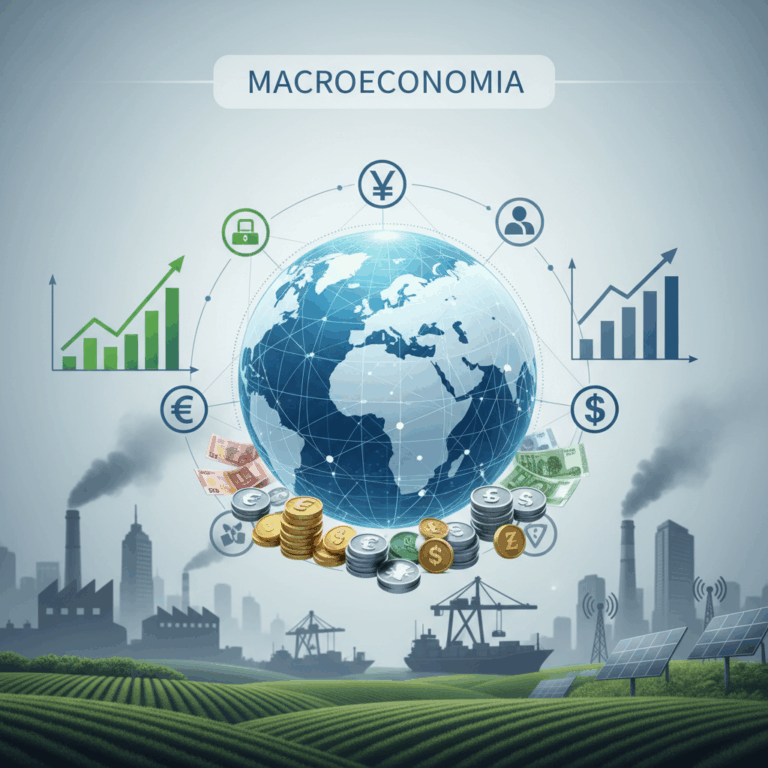Definition and scope of macroeconomics
The macroeconomy It studies the overall behavior of the economy, analyzing large aggregates such as production, prices, and employment, in a country or region.
His analysis addresses how sectors and markets interact, allowing for an understanding of economic trends and cycles, clearly differentiating itself from microeconomics.
General concept of macroeconomics
This branch of economics observes the economy as a whole, measuring the interaction between factors such as GDP, inflation, and unemployment.
It uses qualitative and quantitative methods, as well as mathematical models, to evaluate the impact of public policies.
Its main function is to anticipate economic effects and support the design of efficient fiscal and monetary policies.
Differences between macroeconomics and microeconomics
Macroeconomics focuses on economic aggregates and global phenomena, while microeconomics studies individual agents such as households and firms.
Both areas complement each other, but macroeconomics deals with large-scale problems such as inflation, unemployment, and economic growth.
Microeconomics analyzes specific decisions, while macroeconomics examines how those decisions affect the national or international whole.
Key macroeconomic indicators
Macroeconomic indicators are essential for understanding the economic health of a country or region. They measure variables such as growth, prices, and employment.
This data allows governments and analysts to evaluate policies and make decisions to improve stability and social welfare.
Gross Domestic Product (GDP)
GDP represents the total value of goods and services produced in a country during a specific period. It is the key measure of economic size.
Sustained GDP growth indicates economic expansion, while a decline may signal recession or structural problems.
GDP helps to compare economies and to plan policies that promote development and employment.
Inflation and its measurement
Inflation reflects the generalized increase in prices in the economy, affecting the purchasing power of the population.
Its most common measurement is through the Consumer Price Index (CPI), which monitors the variation of a representative basket of goods.
Controlling inflation is crucial to maintaining economic stability and avoiding market distortions.
Unemployment rate
The unemployment rate indicates the percentage of active people who are looking for work but cannot find it, reflecting the employment situation.
High levels of unemployment affect social welfare and reduce the productive capacity of the economy.
This indicator is key to designing policies that promote job creation and improve labor inclusion.
Balance of payments, fiscal deficit and exchange rate
The balance of payments records all economic transactions between a country and the rest of the world, showing its international position.
A fiscal deficit occurs when public spending exceeds revenue, which can impact the financial sustainability of the state.
The exchange rate is the relationship between the national and foreign currency, affecting exports, imports, and domestic prices.
Application of macroeconomics in public policy
Macroeconomics allows the design of public policies that regulate the economy to promote stability, growth, and social equity.
Analyzing large aggregates such as inflation and employment is vital for deciding on appropriate fiscal and monetary strategies.
Fiscal policies and their impact
Fiscal policies involve the administration of taxes and public spending, directly influencing economic activity.
Increased public spending can stimulate growth, but it can also generate fiscal deficits if financing is not controlled.
Tax cuts can encourage investment and consumption, although they must be balanced to avoid macroeconomic imbalances.
These policies aim to stabilize the economy, promote equality, and improve social welfare in the medium and long term.
Monetary policies and tools
Monetary policies are directed by central banks to control the money supply and interest rates, impacting inflation and employment.
Interest rate management influences credit and consumption; low rates stimulate the economy, while high rates slow it down.
Other tools include open market operations and reserve requirements, which regulate liquidity and financial stability.
The effectiveness of these measures is crucial to maintaining price stability and promoting sustainable economic growth.
Importance of macroeconomics for the global economy
The macroeconomy It is key to understanding how the global economy works, identifying problems and designing solutions that affect all countries.
Their study facilitates the understanding of how global economic variables interrelate, guiding decisions that seek stability and sustainable growth.
Diagnosis and solution of economic problems
Macroeconomics allows us to detect imbalances such as high inflation, unemployment, or financial crises, which affect the overall economic health.
It analyzes structural and cyclical causes, proposing appropriate fiscal and monetary policies to correct problems and promote recovery.
Using models and data, it anticipates the impacts of economic decisions, facilitating a quick and efficient response to international challenges.
Effects of policies on social welfare
Macroeconomic policies directly influence the social welfare by affecting employment, prices, and income distribution.
An effective policy can reduce poverty and inequality, improving the quality of life and social stability in different regions.
Conversely, bad decisions generate economic uncertainty, loss of purchasing power, and increased social exclusion.






